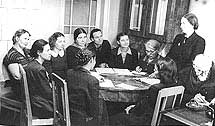Memoirs of Kruglova Olga Vladimirovna (page 4)
 From Tarnoga to Paris
From Tarnoga to Paris
Not just in Tarnoga, but all around it, - in that area rich in wood they did like distaffs with a huge blade. I was everywhere around Tarnoga: in Nuksenitsa on the Sukhon to the South of Tarnoga, in the most remote corner on the Kuloy River to the west of the Tarnoga district, and to the north of Tarnoga on the Ustjya River in the Arkhangelsk Region. There were giant distaffs with huge blades, like spades, everywhere. But the Tarnoga distaffs still stood by themselves. There we came across some exclusive culture of carving on the whole distaff. First of all, the technique of three-faced carving was superb. There were innumerous variants of just several elements characteristic of this technique. The creative fantasy of the ornamental decision was unlimited. But the most important thing in the Tarnoga distaffs was something significant, magnificent and distinct, which matched its simple shape and stressed its monumentality. Besides, a Tarnoga craftsman could admire wood. He seemed to fill his distaff with rich carving just to demonstrate the untouched natural beauty of wood – its color and intricate pattern of fibers.
At first, I liked only distaffs that had smooth wood combined with carved patterns on their huge blades. But it turned out that the thick pattern covering the whole facade of a distaff could be very beautiful too. And I was lucky to see and to acquire for the Museum a real masterpiece with such pattern on my last day in Tarnoga. It was in Denisovskaya village of the Verkhnespassky Village Soviet. They left me there, and the bus went further to the forest station, where the actors were to give two concerts. On their way back almost at midnight there one more concert in the village, where I was working. On that day of all days I had bad luck. May be that was why, when the bus reached the club, I decided to give up and went to the concert with the collective farmers.
The hall was overcrowded. The audience was good-natured, somewhat naive and always sympathetic. It was a pleasure to find myself in such warm atmosphere. I found a place among the spectators. We could hear the actors walk behind the curtain. They moved furniture and tuned the musical instruments. The audience expressed neither impatience, nor nervousness. Everybody was in elevated mood. They were ready to wait for the performance as long as necessary. And what about actors? They tried their best to prepare a good evening to those people.
It was at that time that I saw a young woman entering the hall. She made her way to our side, looking at me. And then I noticed a huge distaff in her hands. I reached for it and people passed the distaff from hands to hands. I looked at it and sat still. The distaff was dark and wet (the woman did not want to demonstrate it dusty and she washed it up right at the well). Yet, carving was clearly seen. It filled the whole blade. How beautiful it was! There was a smooth part for a hand. I put my hand on that polished detail at once.
|


